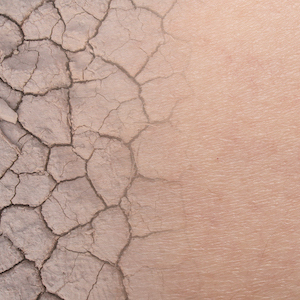What is dehydrated skin?
- Posted on: May 10 2023

Dehydrated skin means one thing: you need water.
From not drinking enough to sweating too much, it’s easy to lose more water than we take in. Dehydration often leaves a person’s skin feeling itchy or dull. Fine lines and wrinkles may become more noticeable. Dehydrated skin can also cause an uneven complexion, dark under-eye circles, and other unwanted issues.
Wondering if you have dehydrated skin or dry skin? The skin care experts at Asarch Dermatology are here to provide you with answers. Learn the differences between dehydrated skin and dry skin, how to test if your skin is dehydrated, and your best options for treatment.
Identifying dehydrated skin vs. dry skin
Many people assume that dehydrated skin and dry skin are one and the same. In reality, they are two different conditions.
In fact, only one of them – dehydration – is actually considered a condition. Dry skin is considered a skin type. Most of us are born with one type of skin (such as normal, dry, or oily), although it can change with age, environment, or season.
While dehydrated skin lacks enough water, dry skin lacks enough natural oils (or sebum). When a person’s sebaceous glands don’t produce enough natural oils, they often must use moisturizer to properly hydrate their skin and restore the outer layer. Frequent washing can also cause dry skin by stripping away natural oils, again requiring extra moisturization.
Signs of dry skin include:
- White flakes
- Redness
- Irritation
- A scaly appearance
On the other hand, signs of dehydrated skin include:
- Itchiness
- A dull, uneven complexion
- Sunken eyes
- Dark under-eye circles (sometimes described as “shadows” under the eyes or around your nose)
- An increase in fine lines and wrinkles
When the signs of dehydrated skin are accompanied by dry mouth, extreme thirst, dizziness, weakness, fatigue, or dark-colored urine, you may be experiencing severe dehydration and should seek medical treatment.
How to test if your skin is dehydrated
Still not sure if you have dehydrated or dry skin? When in doubt, schedule an appointment with your Asarch dermatologist! You can also perform a simple pinch test at home.
Take a small portion of the skin around your cheek area and squeeze it lightly. If the skin doesn’t bounce back after you let go, or you notice any wrinkling, your skin may be dehydrated.
Treating dehydration and dryness
Dehydrated skin
Unlike dry skin, dehydrated skin is treatable with diet and lifestyle changes. (Hint: hydration is key!)
First and foremost, you need to drink plenty of water. Start with the standard guideline of eight glasses of water per day. (You may need to drink more based on your body weight and/or activity level – ask your doctor for a target amount.) Many water cups and bottles now come marked with times and lines that you can follow to make sure you drink all the water you should.
You can also help treat dehydrated skin by:
- Drinking less alcohol, coffee, or other caffeinated drinks (alcohol and caffeine both increase your production of urine, making you more susceptible to dehydration)
- Exercising regularly (remember to rehydrate during and after your workouts)
- Eating more water-rich fruits and vegetables like watermelon or celery
- Not smoking
- Getting enough sleep
If your dehydrated skin does not improve after making these changes, you could have dry skin instead.
Dry skin
Dry skin is more difficult to treat than dehydrated skin, especially during cold and dry Colorado weather. Proper hydration is great for your health – but unfortunately, it doesn’t help at all with dry skin.
Instead, your Asarch dermatologist can recommend a moisturizer that contains the right blend of active ingredients (such as ceramides, lactic acid, or glycerol). Depending on the severity of your dry skin, you may need a prescription moisturizer. We can also treat any underlying skin condition that is causing your skin to dry, such as atopic dermatitis, eczema, or psoriasis.
Other treatment options for dry skin include:
- Limiting showers and baths to 10 minutes or less, using warm water instead of hot
- Using moisturizer immediately after washing
- Using “fragrance-free” soaps and detergents (not “unscented” ones, which may still contain chemicals that irritate dry skin)
- Adding extra moisture to your home with a humidifier
Choosing the right skin treatment
By making the changes listed above, your skin should start feeling and looking better. But if you have dehydrated skin and unknowingly use a product designed for dry skin – or vice versa – you may not see any improvement at all, or your skin could worsen.
It’s time to put an end to the guesswork and get the answers you need! Your Asarch dermatologist will carefully examine your skin and then create a customized treatment plan that’s right for you.
Asarch Dermatology is committed to providing patients of all ages with personalized attention, exceptional skin care, and state-of-the-art technology at our three convenient locations in Englewood, Castle Rock, and Lakewood. We’ll do everything we can to ensure that your experience is a positive one, so schedule your appointment today.
